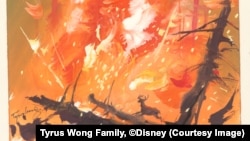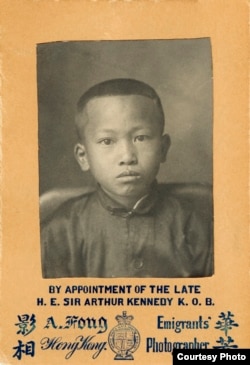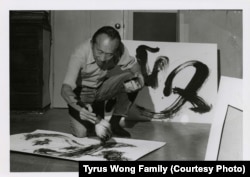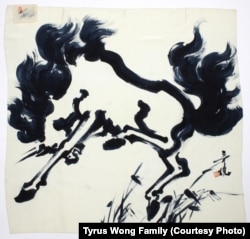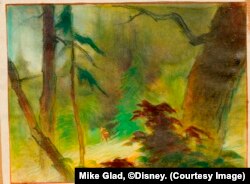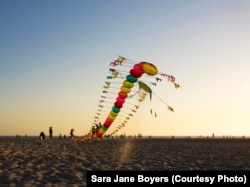The animated Disney classic Bambi has captivated audiences around the world for decades, and Tyrus Wong is one of the reasons why, even if you've never heard his name.
The Chinese-American artist, inspired by landscape painting of the Song dynasty, created the distinctive look of the film. As in the 11th century canvases, intricate and realistic scenes capture attention in the foreground, while the background retains qualities of vast and infinite space.
Wong, who died in the final days of 2016 at the age of 106, overcame poverty and discrimination to become a renowned painter and Hollywood studio artist. But recognition for his work on Bambi was a long time in coming.
An unwelcome start to a new life
Tyrus Wong arrived in the United States in 1920 as a young boy with his father, from a poor village in Guangdong Province in China.
“And he came to America during a time when there was great hostility towards the Chinese,” notes filmmaker Pamela Tom, who chronicled his life story in a new documentary called Tyrus.
“The Chinese Exclusion Act was in effect, which barred all Chinese from entering unless you were a merchant, a student, a diplomat or a missionary. And so he had to come under an assumed identity and was detained at Angel Island, which was what they called the Ellis Island of the West, but really in reality it was a detention center, and it was a place that they could hold the Chinese in the hopes that they could just send them back to China.”
The Wongs eventually settled in Los Angeles. His father encouraged him to practice calligraphy. Since they couldn’t afford ink or drawing paper, he’d dip his brush in water and draw characters on old newspapers.
He recalled, “My father make me draw every night… And he’d come over… [he’d say] ‘hold the brush right’… I almost fall asleep holding it like that.” Eventually, Wong attended art school, where he studied art during the day and worked there as a janitor at night.
“I love to paint,” he says in Tom’s documentary. “Anything else, I’m no good at all.”
But he was more than just good as a painter. He was a leading figure in the Modernist movement that flourished in California between the first and second World Wars. In the 1930s, his work was included in group shows at the Art Institute of Chicago that also featured Picasso, Matisse and Paul Klee.
But making a living as a fine artist wasn’t easy. So Wong got a job at the Walt Disney Studio in 1938, as an “in-betweener,” drawing the frames “in between” the animator’s key drawings.
Bambi, The Wild Bunch and more
When Wong learned that Disney was making a film based on Felix Salten’s novel, Bambi, a Life in the Woods, he drew sketches of deer in a forest and showed them to his supervisor. Those images caught Walt Disney's eye, and his artwork ended up inspiring the visual look of the film.
But he was fired before Bambi was completed in 1942, after a labor strike, and animation historian, John Canemaker says his contributions to the film were never fully recognized. “Tyrus was credited as one of the background painters, but that’s not what he did. He was that film in terms of the design and he was not properly credited for it.”
Wong went on to become a pre-production illustrator at Warner Bros., where he worked on more than a hundred live action films including Rebel Without a Cause and The Wild Bunch.
Pamela Tom hopes his story will inspire others who want to pursue their dreams. “I think people just have to realize and remember how unusual it really was at that time for an Asian to be working in Hollywood and what he was up against, you know the prejudice and discrimination... For him to overcome that and endure, and to have a sustained career for over 30 years in the film industry at that time is just remarkable.”
In addition to his work in films, Wong also created fine art, top-selling greeting cards and Asian-inspired designs for dinnerware.
Belated recognition for a pioneering artist
Tyrus Wong's contributions to American art and culture were belatedly recognized in 2001, when he was named a Disney Legend, and in 2013, the Walt Disney Family Museum mounted a retrospective of his art.
“When you look at these paintings, you can almost feel the morning dew on the forest, or you can almost smell the fresh air and the moss and the feel of the forest,” says exhibition curator Michael Labrie, adding, “that’s the beauty of Tyrus’s work, he tells a story and you get an emotion from the art.”
And you get that emotion from just a few lines and washes of color. Labrie says Tyrus’s innovative approach transformed the art of animation. His vision for Bambi was the polar opposite of the exquisite detail of Disney’s previous film, Snow White.
"Because [the Disney studio] had been struggling with Bambi after doing Snow White, and everything was very detailed… the animals were getting lost in the forest. The idea that he was able to create the depth and feel of these massive forests and meadows with a few lines. I think that was revolutionary in the animation field... Not only did you fall in love with the animals, you fell in love with the forest."
And many artists fell in love with his work, including Oscar-winning filmmaker Ralph Eggleston, a production designer at Pixar Animation Studios. Eggleston says the impressionist approach to “Bambi” inspired their approach to the film, “Finding Nemo.” And Tyrus Wong’s artwork continues to inspire him today.
“He’s the very definition of someone who really understood the term inspirational art. It was artwork that was meant to inspire an entire crew of people… His impact to the artists at the time the film was made was also as strong as what it’s become in the minds of all of us since.”
After retiring in 1968, Tyrus Wong continued to share his art with the world by creating whimsical kites, flying butterflies, flocks of birds and 30-meter-long centipedes. As they soared over Santa Monica Beach, it seemed as if he was still painting… but this time, his canvas was the sky.
A celebration of his life was held Friday in Los Angeles.




